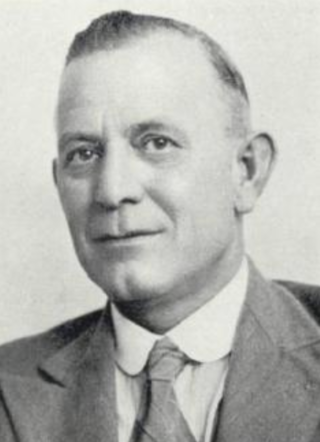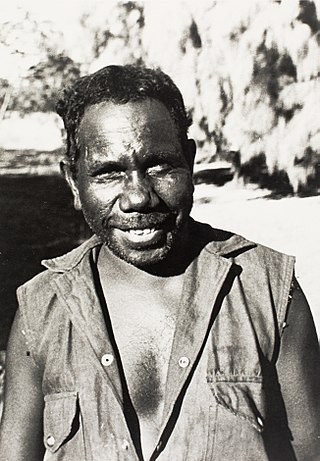Related Research Articles

The second question of the 1967 Australian referendum of 27 May 1967, called by the Holt government, related to Indigenous Australians. Voters were asked whether to give the Commonwealth Parliament the power to make special laws for Indigenous Australians in states, and whether Indigenous Australians should be included in official population counts for constitutional purposes. The term "the Aboriginal Race" was used in the question.
The Wave Hill walk-off, also known as the Gurindji strike, was a walk-off and strike by 200 Gurindji stockmen, house servants and their families, starting on 23 August 1966 and lasting for seven years. It took place at Wave Hill, a cattle station in Kalkarindji, Northern Territory, Australia, and was led by Gurindji man Vincent Lingiari.
The Australian Workers' Union (AWU) is one of Australia's largest and oldest trade unions. It traces its origins to unions founded in the pastoral and mining industries in the late 1880s and it currently has approximately 80,000 members. It has exercised an outsized influence on the Australian Trade Union movement and on the Australian Labor Party throughout its history.
The Northern Land Council (NLC) is a land council representing the Aboriginal peoples of the Top End of the Northern Territory of Australia, with its head office in Darwin.

Vincent Lingiari was an Australian Aboriginal rights activist of the Gurindji people. In his early life he started as a stockman at Wave Hill Station, where the Aboriginal workers were given no more than rations, tobacco and clothing as their payment. After the owners of the station refused to improve pay and working conditions at the cattle station and hand back some of Gurindji land, Lingiari was elected and became the leader of the workers in August 1966. He led his people in the Wave Hill walk-off, also known as the Gurindji strike.

Kalkarindji is a town and locality in the Northern Territory of Australia, located on the Buntine Highway about 554 kilometres (344 mi) south of the territory capital of Darwin and located about 460 kilometres (290 mi) south of the municipal seat in Katherine.
The history of the Northern Territory began over 60,000 years ago when Indigenous Australians settled the region. Makassan traders began trading with the indigenous people of the Northern Territory for trepang from at least the 18th century onwards.

Charles Lydiard Aubrey Abbott was an Australian politician and public servant. He served as administrator of the Northern Territory from 1937 to 1946, a period encompassing the bombing of Darwin and other Japanese air raids on the territory during World War II. Originally a grazier from New South Wales, he was a Country Party politician prior to his time in the Northern Territory and served as Minister for Home Territories in the Bruce–Page government from 1928 to 1929. He was a member of the House of Representatives from 1925 to 1929 and 1931 to 1937, representing the seat of Gwydir.

Arthur Blakeley was an Australian politician who served in the House of Representatives from 1917 to 1934, representing the Labor Party. He was the party's deputy leader from 1928 to 1929 and served as Minister for Home Affairs in the Scullin government (1929–1932).

Herbert Victor Johnson was an Australian politician. He was a member of the Australian Labor Party (ALP) and served in the House of Representatives from 1940 to 1948. He was Minister for the Interior in the Chifley government from 1945 to 1949.

The Darwin rebellion of 17 December 1918 was the culmination of unrest in the Australian Workers' Union which had existed between 1911 and early 1919. Led by Harold Nelson, over 1,000 demonstrators marched on Government House at Liberty Square in Darwin, Northern Territory, Australia where they burnt an effigy of the Administrator of the Northern Territory, John Gilruth, and demanded his resignation.
Joe Walker was an Australian novelist, newspaper editor and union leader.
Daguragu, previously also known as Wattie Creek by the Gurindji people as it is situated on a tributary of the Victoria River, is a locality in the Northern Territory of Australia. It is located about 551 kilometres (342 mi) south of the territory capital of Darwin and located about 460 kilometres (290 mi) south-west of the municipal seat in Katherine. It is around 8 km (5.0 mi) north-west of Kalkarindji. Daguragu community is situated on Aboriginal land held under perpetual title; it was also formerly a local government area until its amalgamation into the Victoria Daly Shire on 1 July 2008.

Wave Hill Station, most commonly referred to as Wave Hill, is a pastoral lease in the Northern Territory operating as a cattle station. The property is best known as the scene of the Wave Hill walk-off, a strike by Indigenous Australian workers for better pay and conditions, which in turn was an important influence on Aboriginal land rights in Australia.
Cecil Evelyn Aufrere (Mick) Cook was an Australian physician and medical administrator, who specialised in tropical diseases and public health. He was appointed as Chief Medical Officer and Protector of Aborigines for the Northern Territory in 1927. He established much of the infrastructure of the public health system there, including four hospitals, a tuberculosis clinic, a nursing school and the Nurses’ Board of North Australia. He started the Northern Territory Aerial Medical Service together with Dr Clyde Fenton, and he was founding chairman of the Northern Territory Medical Board.
Limbunya Station is a pastoral lease that operates as a cattle station in the Northern Territory of Australia.
Brian Thomas Manning was an Australian trade unionist and political activist. He was active in supporting the Gurindji strike at Wave Hill, a pivotal event in the early Australian Aboriginal land-rights movement. He was also heavily involved in the campaign for an independent East Timor as well as the anti-racism movement and a number of other causes. He was a dedicated trade unionist, a secretary of the Northern Territory branch of the Waterside Workers' Federation of Australia and a co-founder of the Northern Territory Trades and Labor Council.

Dexter Daniels or Nubuluna was a Numamurdirdi man from south-east Arnhem Land and pioneering activist in the struggle for Aboriginal rights and land rights in Australia during the 1960s and 1970s. Daniels came to public attention as the breakaway Aboriginal Organiser of the North Australian Workers' Union (NAWU) in 1966 and was integral in supporting the Wave Hill walk-off.
Gurindji is a locality in the Northern Territory of Australia located about 459 kilometres (285 mi) south of the territory capital of Darwin.
Woodgreen Station, also spelt Wood Green and also known as Atartinga, is a cattle station located in the Northern Territory of Australia, to the northeast of Alice Springs, extending approximately 2,215 km2 (855 sq mi). It was also known as (Mer) Athatheng by some of the Indigenous people in the area.
References
- ↑ Federated Miscellaneous Workers' Union of Australia. North Australian Workers' Union Branch (1932), The Northern standard. [newsletter of the North Australian Workers' Union Branch (NAWU)], North Australian Workers' Union, retrieved 6 July 2017
- 1 2 Martínez 2005, p. 102.
- 1 2 Martínez 2005, p. 103.
- 1 2 Martínez 2005, p. 104.
- ↑ Martínez 2005, p. 105.
- 1 2 Martínez 2005, p. 111.
- ↑ Martínez 2005, pp. 112–113.
- ↑ Martínez 2005, p. 117.
- ↑ Australia. Commonwealth Conciliation and Arbitration Commission; Kirby, Richard, 1904–2001; North Australian Workers' Union; Australia. Cattle station industry (Northern Territory) award (1966), In the matter of Cattle Station Industry (Northern Territory) Award, 1951 : application by the North Australian Worker's Union to vary by deleting the exclusion concerning Aboriginals and domestic servants (Clauses 3 and 6) : judgment of the Commission, Commonwealth Conciliation and Arbitration Commission, retrieved 6 July 2017
{{citation}}: CS1 maint: multiple names: authors list (link) CS1 maint: numeric names: authors list (link) - ↑ North Australian Workers' Union, applicant; Australia. Commonwealth Conciliation and Arbitration Commission, Transcript of proceedings, Commonwealth Reporting Service, 1983, retrieved 6 July 2017
- ↑ "Gurindji strike for their land". Deadly Story. Victoria Government . Retrieved 8 August 2020.
- ↑ "North Australian Workers Union - Trade Union entry". Australian Trade Union Archives (ATUA). University of Melbourne. 7 March 2002. Retrieved 9 August 2020.